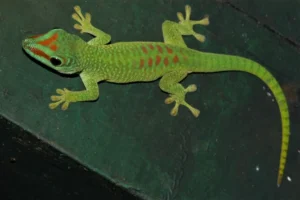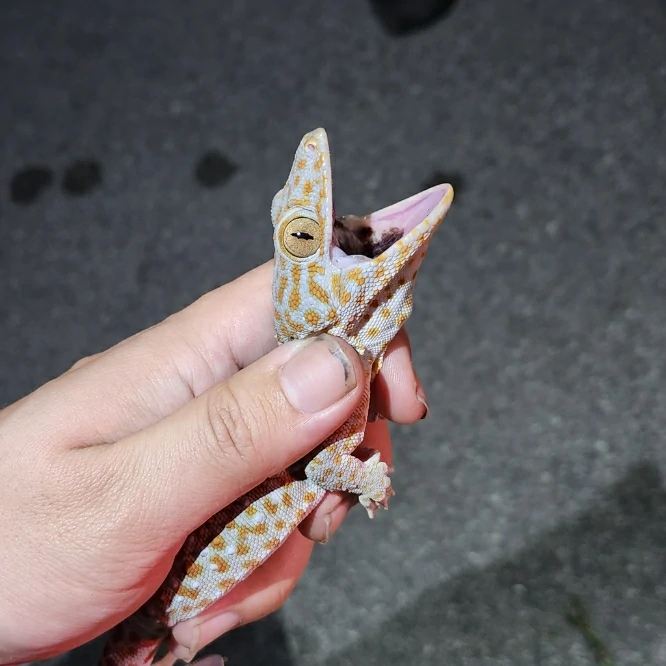It’s late at night, and your gecko is slowly moving around its tank. You notice it stretch its tiny jaws open wide, almost like it’s taking a deep breath. Then it closes them and rests. You pause and wonder, does your gecko actually yawn, or is this just a weird reflex?
Yes, geckos do sometimes yawn, but it’s not like human yawning. Their wide jaw stretches have practical purposes: keeping their jaws flexible, clearing their mouths of debris, adjusting pressure in their head and throat, and even signaling certain behaviors. Basically, when a gecko “yawns,” it’s doing something functional, not just showing tiredness like we do.
Once you start noticing, you’ll see that these small movements can tell you a lot about your gecko’s health and behavior.
What a Gecko Yawn Looks Like
If you haven’t watched closely, a gecko’s yawn can be easy to miss. They usually open their mouths wide, sometimes stretch their body slightly, and may flick their tongue.
The jaw stays open for a few seconds and then closes smoothly.

Unlike humans, geckos rarely take a deep breath during a yawn. It’s more about movement than inhaling.
In some species, like leopard geckos, you might see a subtle pulse in the throat as they open and close their jaws.
It’s a small, simple motion, but it can tell you a lot if you pay attention.
Why Geckos Yawn
Geckos yawn for several practical reasons. Here’s what it usually means:
1. Stretching the Jaw Muscles
Just like us, geckos’ muscles need stretching. Their jaws get used for biting insects and handling food. Stretching them with a “yawn” keeps the muscles loose and ready.
In the wild, a gecko might yawn after resting before it starts hunting. That little stretch makes sure it can snap at crickets, roaches, or other prey without strain.
2. Cleaning the Mouth
Geckos don’t brush their teeth. Sometimes opening their mouths wide helps dislodge tiny debris or leftover food bits.

For example, if your gecko just finished a cricket, a wide jaw stretch can remove small fragments near the teeth or tongue. Think of it as a natural self-cleaning trick.
3. Adjusting Pressure
Some geckos use jaw stretches to adjust pressure in their head and throat. You might notice this more in species with bigger heads or wider mouths, like tokay geckos.
Opening the mouth helps balance blood flow or keep the jaw aligned. It’s a small, functional action you might miss if you’re not looking closely.
4. Communication and Signaling
Geckos are quiet, but they do talk in subtle ways. A jaw stretch can be a signal to other geckos, especially in social or territorial situations.
For instance:
-
A gecko might open its mouth slightly when another gecko comes close, showing mild warning.
-
Some species use this movement in courtship or to show dominance.
What looks like a yawn to us can actually be a meaningful message in gecko language.
5. Temperature and Hydration
Some experts think jaw stretches might help manage heat or moisture in the mouth and throat.
This is especially true for geckos in dry or warm places. In captivity, the effect is subtle, but in the wild, every little movement helps keep their body balanced.
Watching Gecko Yawning in Captivity
If you keep geckos as pets, you might notice yawns at different times:
-
Morning: After resting overnight, before they start moving or hunting.
-
After meals: Helping clear the mouth or stretch the jaw.
-
Evening or night: Before a period of activity.
These yawns are normal. Most of the time, there’s no reason to worry unless you see things like:
-
Constantly open mouth without closing
-
Drooling or bubbles from the mouth
-
Trouble breathing
If any of these happen, it’s a good idea to check with a reptile vet.
How Different Gecko Species “Yawn”
Not all geckos yawn the same way:
-
Leopard geckos: Subtle jaw stretches for muscle flexibility and cleaning.
-
Crested geckos: Quick open-and-close movements while exploring or adjusting posture.
-
Tokay geckos: Can be more dramatic, sometimes part of warning or territory display.
-
Day geckos: Rarely show yawning, but small jaw flicks may happen after feeding or activity.

Watching closely, you’ll see yawning varies by species, personality, and situation.
When to Worry About Gecko Yawning
Most yawns are harmless, but some signs need attention:
-
Labored breathing
-
Constant open mouth without closing
-
Foam, bubbles, or unusual discharge
These could point to respiratory infection, mouth rot, or other health problems. In those cases, contact a reptile vet.
Otherwise, jaw stretches are normal. They help your gecko take care of its body and communicate.
Fun Facts About Gecko Mouth Movements
-
Geckos may combine yawning with tongue flicks to sense leftover prey or particles.
-
Baby geckos sometimes yawn more often while their jaws and muscles are growing.
-
Even wild geckos yawn before hunting or after resting, showing it’s a natural behavior across species.
These little movements show how geckos balance body care, communication, and survival all at once.
Conclusion
So, do geckos yawn? Yes, but not like humans.
Their “yawns” stretch muscles, clean the mouth, adjust pressure, and sometimes send messages to other geckos.
Next time your gecko opens its jaws wide, watch closely. That tiny gesture is a small window into its life, showing how even little lizards take care of themselves and interact with the world.
Gecko yawns may be subtle, but they remind us that even the smallest creatures have smart, practical ways of staying healthy, aware, and ready for whatever comes next.
Hi, my name is Ezra Mushala, i have been interested animals all my life. I am the main author and editor here at snakeinformer.com.

